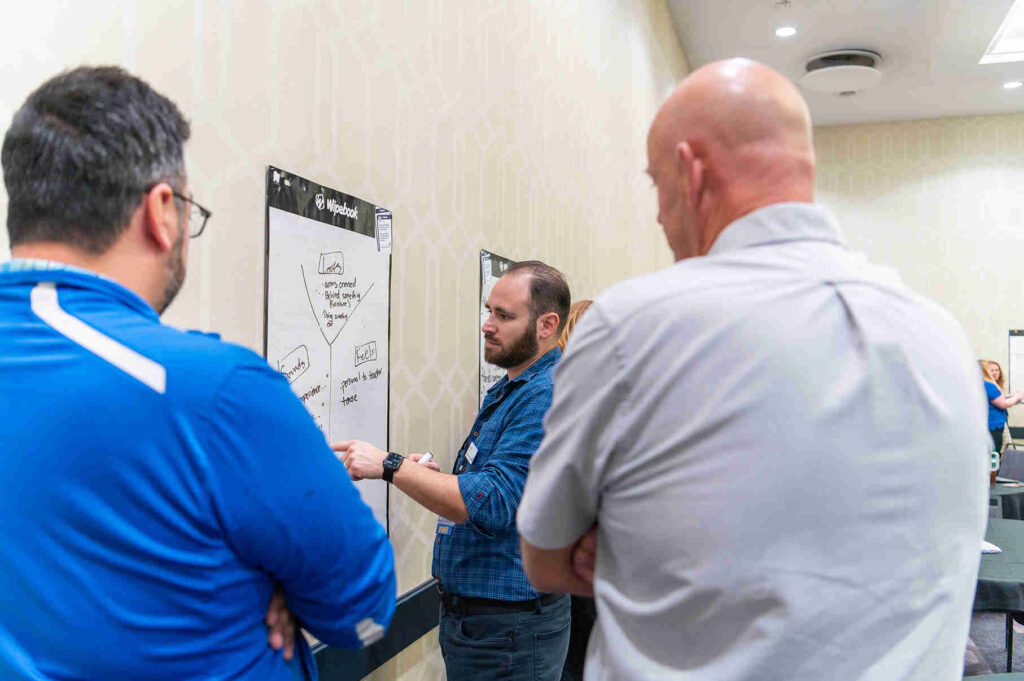
We hope you can name a time you really worked to learn something and that you remember the pride and satisfaction you felt when everything came together. Overcoming an obstacle is so powerful, we have no doubt you still remember what you learned. However, in this day and age, struggle is a struggle. Living through a pandemic was hard. In many ways, we are all trying to get back in shape to handle other challenges. And many of us are doing it in a culture that sends very mixed messages about the value of struggle. Athletes pour themselves into training until their weaknesses become their strengths. Parents nervously stand back to watch their children figure out how to ride a bicycle because, ultimately, they can only learn through the struggle of falling and getting back on the bike. But what about math students? Should teachers rescue their students when they get stuck? Are parents proud of their children when you call to say they are struggling? What does an educator mean when they talk about their “strugglers”? So often in schools, struggling is a weakness to be fixed. But what if struggling conveyed strength? What if the struggle was necessary, important, and expected?
Reflecting on Your Beliefs
Teachers in student-centered classrooms must believe that students can and should solve rigorous math problems. “By challenging them and supporting them through struggle, you can help them build the strategies and thinking they can carry with them into their futures” (SanGiovanni et al., 2020, p. 16).
We want to take a moment and invite you to reflect on some of your own beliefs.
“The fact is beliefs do matter, and what we actually do says more about what we believe than what we may say we believe” (Wells, 2024, p. 110).
What might you say or do that will tell your students you want them to have the pride and satisfaction that comes from working through a good challenge?
Seemingly Insignificant Choices and Productive Struggle
Now that we have had time to reflect, let’s consider why seemingly insignificant instructional choices have significant impacts on productively struggling during learning. Grappling with this idea has led us to take action on our own student-centered instructional choices. Seeing learners as knowledgeable was our first idea to embrace. From there, it was about creating opportunities to share students’ knowledge in barrier-free ways. We implemented a Door Question every day. We asked questions like, “What is something you do right after school?” Learners might respond, “I like to go for a two-mile jog before beginning any homework.” In this case, it would turn out that running was a social connection between our learners and us, a connection formed in under 20 seconds. We paired this simple strategy with other student-centered strategies throughout the year to empower learners to transfer ideas while seeing their classmates as knowledgeable.
Just as we become stronger through activities like a dedicated running routine, we recognize a need to nurture our classroom community with daily routines. We acknowledged that if we only completed a good stretch and committed to a light jog for the first two days of school in August or September, we would surely be unprepared to complete a marathon in May or June. The same was true for building a strong classroom community. To better support our learners in persevering and productively struggling, we need to collectively respect our personal setbacks, shared traumas, injuries, failures, and, yes, successes. At times in our teaching career, we failed to allow learners to share their negative (or positive) feelings about struggle.
Supporting Openly Sharing Ideas with Prompts
We also recognized that learners lacked the prompts to share openly about their ideas. We found sentence and question frames to be highly effective as a student-centered strategy.
Sometimes there were simple misunderstandings, such as learners leaving manipulatives and/or other resources out after an activity. One team member might become frustrated by unfairly cleaning the whole workspace. By providing a sentence frame like, “I will put away the _____, while you put away the _____,” we observed something very notable. Learners were more cooperative because they viewed it as a more equitable way to accomplish the task. At other times, we recognized that learners were being interrupted when communicating their ideas. Offering the question frame, “[ Name ] started to say something and did not get to finish. Can we hear more about what they had to say?” encouraged team members to help each other share more equitably, since it was no longer about who was fastest to respond.
Too often, learners reported feeling unheard by their teammates. Providing general sentence frames (like these, adapted from CPM’s Inspiring Connections series) sustained discussions longer each period.
- What did you mean when you said _____?
- [ Name ], you have been quiet. Do you feel excluded from the conversation?
- I am getting frustrated. Will you help me _____?
- I am not sure I am convinced yet. How do you know this is true?
- My thinking was different because _____.
- I want to hear more _____, but right now, we are working on _____.
Reinforcing Productive Struggle Throughout the Whole Year
After experiencing initial success early in the school year, we recognized that student-centered strategies needed to be reinforced throughout the whole school year as a routine to promote productive struggle in learning. Daily Door Questions reinforce that learning math is social; therefore, social connections are needed to productively struggle. Providing sentence frames reinforces a culture of discourse-based discussions. Once the discussions improved, the class gradually shifted the focus to assets rather than being stuck on deficits. We witnessed cycles of discussions and reflections about what they needed through rough draft ideas, team collaborations, independent reflections, and refinements. As the learners became more knowledgeable about how they learned, how they communicated their ideas, and the impact they had on others, they were also more supportive of helping their teammates be successful.
References:
SanGiovanni, J. (2020). Productive math struggle: A 6-point action plan for fostering perseverance. Corwin.
Wells, L. M. (2024). There are no deficits here: Disrupting anti-blackness in education. Corwin.

Jeremiah Morgan & Jocelyn Dunnack
jeremiahmorgan@cpm.org (Eagan, MN)
joceylndunnack@cpm.org (Columbia, CT)
